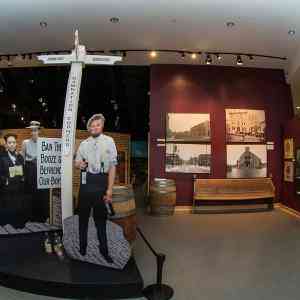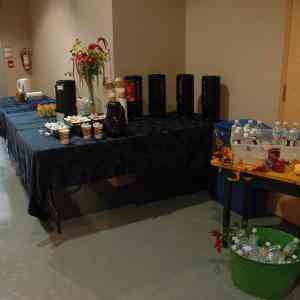Grey Roots Museum & Archives has grown and developed into a unique facility from the County Museum's beginning in 1955 and the later establishment of a County Archives in 2000 in order to promote and preserve the heritage of Grey County.
Initial interest for a Grey County Museum began by the forming of a committee to establish a museum project, displaying borrowed artefacts in a temporary space. A permanent home became realized in 1959 by the work of the Grey County Historical Art Society and the purchase of a church building in Owen Sound followed by the official opening of an Art Gallery and Museum accommodation.
By 1967 the need for greater space led to an agreement by the municipalities of Grey County and the City of Owen Sound to jointly sponsor the building of a museum. On June 3 of that year the Grey County-Owen Sound Centennial Museum was officially opened at 6th Street in Owen Sound. This was followed by the encouragement to establish a County Archives.
About twenty years ago the Grey County Historical Society in co-operation with the Women's Institutes of Grey County, began work to establish a permanent Grey County Archives. In 1998, the Society set up its own archives in Durham. In 1999 a site for the County operated archives was established in the former Glenelg Township Municipal Building and officially opened its doors as the Grey County Archives on July 6, 2000.
With the growing expansion of both the museum and archives, the County acted to bring together both facilities. The new and current facility, Grey Roots Museum & Archives, which also includes Grey County Tourism, had its grand opening on June 18, 2004.
Today the facility continues to grow with the development of a Heritage Village and the acquisition of both museum collections and archival materials.
Material for this history was derived in part from a speech given by Viola Bothwell at the Museum's 50th anniversary in 2005.
In 1852, the County of Grey, named after Charles the second Earl of Grey, was established. It united various townships under a common name and by 1854 Grey County became separated from the counties of Wellington and Simcoe.
From its beginning, natural resources were integral to the development and expansion of trade and commerce. Resources such as fish, fur, forests and minerals were of great importance. The growth of gristmills and sawmills required the use of the area's river power.
A series of Minister’s Orders from the Province in the late 1990s brought a wave of amalgamation to Grey County. By the early 2000s, 26 municipal entities were reformed to become eight. The City of Owen Sound also rejoined the County to bring the count to the nine municipalities represented at Grey County Council in present day.
For additional information check out the following:
D+ C Develops a logo to bring the stories of Grey together
Design + Communications Inc. (D+C) developed the brand for Grey Roots building on the themes of Forests, Farmland, Water and Rocks. The logo integrates many of the concepts of the interpretative plan for the facility and symbolizes the stories of the strength of the Grey County peoples and their interaction with these elements.
The design is based on the agricultural image of a sheaf, which is represented by the yellow. This image was chosen because agriculture dominates the heritage of Grey County. D+C Inc. then creatively and effectively introduced new colour to represent the other key elements.
By changing the symbol to green... the symbol takes on the outline of a tree which represents the forests.
By changing the symbol to grey… the symbol takes on the outline the rock wall of the escarpment, which represents the rock.
By changing the symbol to red… the symbol takes on the outline of fireworks or celebration of people.
By changing the symbol to blue… the symbol takes on the outline of a waterfall which represents water.
One strand from each of the five key themes is integrated into the final concept of this design. All of these symbols allow us to tell the many stories about the people of Grey County - people in the past, present and future. These symbols were then merged to create one simple, yet deeply meaningful image to represent Grey Roots: Museum & Archives.
Natural Forms Versus Human Geometry
The entrance is marked by a stone walkway in the entrance courtyard and is set at an angle to the basic geometry of the building. The building is generally set out to be parallel with east-west alignment of Grey Road 18 and, therefore, the predominant survey grid. As a result, while the greater part of the building is oriented with respect to Grey Road 18, the entrance pathway alignment reflects the angular alignment of Highway 10 as it cuts across the concession grid of Grey County. Further, we selected a rectangular shape for the stone tiles in the foyer and the entrance walkway reflect the proportions of the rectangular concession grid of Grey County. The result is a stone floor pattern that resembles the map of Grey County.
We have also incorporated "natural" curves and waveforms in the foyers to represent the intersection of the human geometry and the natural shape of watercourses and the Niagara Escarpment. A stone wall on the east side of the foyer and the blue bulkhead above it follow a serpentine course. Similarly, the cabinetry designed for the reception and gift shop follow a curvilinear geometry as does the suspended track lighting above it.
Finally, the waterfall designed and built by Ms. Marnie Talbot adds a real water feature to the space. She has stacked Niagara Escarpment limestone in a naturalistic way in contrast to the regular grid expressed in the stone tile and timber of the foyer. This waterfall represents the many waterfalls of Grey County and recalls the historic importance of waterpower to the early European settlers.
The Use of Grey County Material
Significant materials featured in the design of Grey Roots are concrete, stone, timber, maples hardwood and white cedar. These materials were significant to the historic economy of Grey County. Added to this pallet are various metals including clear anodized aluminium, silver metal siding and painted steel structure, all intended to provide a pallet of various shades of grey. These materials are also used in the main foyer of the building. Where possible, we specified materials that are available in Grey County and originated in Grey County.
The exterior of the building is covered in grey limestone quarried by Ledgerock Industries from the Niagara Escarpment formation near Owen Sound. Stone is also used as the pavement forming the main entrance pathway in the entrance courtyard. Ledgerock Industries is a thriving local business the exports Escarpment stone throughout North America.
Locally harvested white cedar was milled and dried to be used as the exterior sunscreen device located along the curved wall at the west end of the building; as the bevelled siding on the curved wall and as the soffit in various locations including the underside of the main entrance canopy. The vertical orientation of the sunscreen will create a shadow pattern on the building that recalls the light and shade pattern formed by barn siding.
All steel elements used at the exterior are painted with a galvanized paint to provide a grey/silver patina. Metal sidings used are painted silver and window and doorframes are a natural aluminium colour. As the cedar components are exposed to sunlight, they will age to a silver colour that, with the metals and stone, will complete the grey pallet of colours. We felt that the gentle aging of the building materials would allow the main building some association with the period buildings in spite of its much greater size.
The use of stone and wood continues inside the building. The foyer is conceived as a contemporary and sophisticated barn using a timber framed structure made from reclaimed timbers, the Escarpment stone floor previously mentioned as well as hardwood accents. The hardwood used for interior door frames, various trims and the horizontal sunscreens inserted in the timber frame is Grey County maple harvested from Grey County managed forests and locally dried and milled.
Concrete is used to form the heated bench that has been built into the main entrance wall. This has been left exposed with a ground finish to highlight the aggregate. It is anticipated that the sensation of sitting on the warm concrete will be a surprise to most visitors. All aggregates used in the construction were extracted from local quarries and all concrete was mixed and delivered from local concrete plants.
~ G.M. Diemert Architect Inc.
The agriculture theme is introduced at the exterior of the building in the form of the service berry orchard located at the west end of the building. This orchard is symbolic of the fruit tree farming common in Grey County.
The theme is continued in the loggia that follows the exterior curved wall west of the entrance and throws the vertical shadows that are evocative of the light and shade created by barn siding. The cedar materials will further evoke the barn siding patina as they weather to their distinctive grey/silver colour.
Inside the building, the timber framed foyer is intended to evoke the qualities of the Grey County barn in a contemporary way. The pattern of light and shade typical in the wood sided barn is turned horizontally and created by maple sunscreens incorporated into the higher sections of the timber framing. The timber framing itself is configured with a king post design instead of the typical pitched roof of a barn and the ceiling is flat rather than sloped. Fittings, cabinetry and lighting are all contemporary in design to reflect Grey County's growth as a vibrant part of twenty-first century Ontario.
Agricultural themes are best represented in the permanent exhibit and, eventually, in the period building display. Indeed, the stone lifter was chosen as a symbol for the project and, as such, it takes pride of place at the heart of the permanent exhibit space. It was felt that this artefact best represented the character and nature of the early European settlers in Grey County.
~ G.M. Diemert Architect Inc
Although not necessarily apparent to the visitor, the design team and the County of Grey invested a great deal of time and money in the design of features intended to save energy. Museum standards require this building to have a high degree of control over humidity and temperature. This requirement means that humid air will be introduced into the building during the winter and that the building could require a low level of air conditioning even during cooler weather. This means that the building envelope is a critical part of the energy efficiency and long-term viability of the construction materials.
The building envelope is highly insulated and features a sprayed-in-pace rubberized air and vapour barrier at the inboard side of the exterior wall with 8 inches of batt insulation (containing recycled slag material from steel production) and sprayed-in-place polyurethane foam at the outboard side. We also incorporated a unique double wall design that will allow future exhibit designers, electricians and others to route new wiring, hang new exhibits or otherwise penetrate the interior gypsum board without risk of damaging the critical rubber air/vapour barrier. This is essentially a second interior, non-load bearing, stud wall that follows the exterior wall and protects the expensive air/vapour barrier from damage.
The mechanical system utilizes ground source heat through a horizontal ground loop buried to the north of the building and heat pumps usually used for ice making in hockey rinks. Further, the Ontario Building Code required that an on site storage tank be available to supply water for the sprinkler system and on site fire fighting. The heat pump loops also use this water as part of the ground loop heat sink. The heat pumps themselves are Canadian technology and use denatured grain alcohol as the heat transfer medium rather than water or caustic substances such as ammonia. This system is connected to the rooftop equipment described below, a snow melting system in the entrance courtyard and a band of in-floor heating around the entire perimeter of the building. This will ensure that the area at the juncture of the foundation wall and the floor slab is warm and free of condensation that could generate mould in the relatively humid environment required for artefacts. The foyer is also heated in the floor for its entire extent in order to keep this surface dry.
Efficient rooftop heating, ventilation and air conditioning units augment the ground loop system. These have natural gas as a back-up heat source and contain humidity control. These units will handle heating and cooling during spring, early summer and fall with the ground loop system and gas will provide additional heat at the coldest part of the winter while electricity will provide the energy for cooling during the peak of summer.
Lighting fixtures (except for display lighting) use high output fluorescent lamps to conserve energy and occupancy sensors are intended to turn lights off in certain areas when no movement is sensed.
~ G.M. Diemert Architect Inc
Vision
Grey Roots is the place people come to understand and reflect on their place in the world – past, present and future - while instilling a sense of pride and belonging, thereby building better communities.
Mission
Grey Roots engages and educates our communities in the human and natural history of Grey County by preserving and sharing collections, stories and memories that define our collective identity and guide our future.
Values
We share the County of Grey values of: Leadership, Teamwork, Communication, Respect and Fiscal Responsibility.
Guiding Principles
Authenticity in interpretation, exhibits, and restorations;
Professional Integrity in research and content;
Life Long Learning for our visitors and staff;
Environmental sustainability including best practices in building & artefact preservation;
Quality exhibits, programs and service excellence with emphasis on inclusivity.
Grey Roots represents the peoples and cultures of this rich region, recording their past, and honouring their present and future. Fittingly, the first visitor experience at Grey Roots is an Aboriginal one. Grey Roots includes an indigenous plant garden in its welcoming area in front of the main building, with flowers, herbs and tobacco. This garden is designed as a living medicine wheel, aligned with the four directions.
This project was made possible in part thanks to the generous support of Community Foundation Grey-Bruce.















